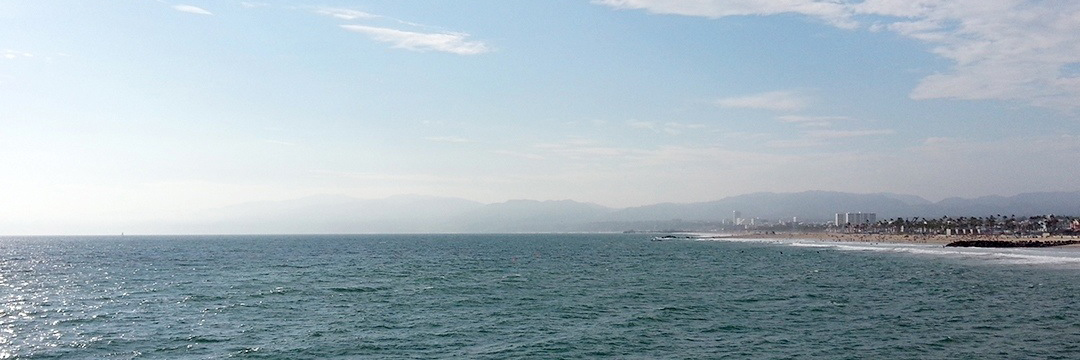
Venice Beach, Santa Monica, 2013
July 2013
SIGGRAPH 2013
Dane Aleksander—creature effects artist in… Santa Monica, California.
The Anaheim Convention Center hosted nearly twenty thousand artists, research scientists, gaming experts, developers, filmmakers, and academics. Economics aside, the state of the VFX industry from a qualitative standpoint is ahead of its time. The role of visual effects in film is undeniably undervalued and as a result, studios are examining how to streamline the latest advancements in computer-graphics (CG). We are in a phase of optimization—of exploring efficiency within the architecture of the tools we use from concept through to post-production. Being exposed to the points of integration of academic work in our computer graphic tools was awe-inspiring. As a first time attendee, it is difficult to assess just how inspiring of awe this independent research was in the context of past events. Likewise, I have no evidence to support an impression of the exhibition floor as a shadow of its former space.
In this articles, I instead share notes on apporaches to an ‘art-directable’ production pipeline, which was the common thread of select presentations at this years computer animation festival, and the next major trend already sweeping digital studios.
“Art-direction”
Director of The Blue Umbrella (animated short film, 2013)—Saschka Unseld shared his experience within the production pipeline at Pixar and Blue Sky presented work on Epic (2013) that conveyed a similar art-directed proficiency.
Art direction is explored and refocused throughout the creative process, beginning with extensive pre-production. Saschka explained how story gives form to an emotion and the feeling serves to shape the film. Artistic style is then directed to focus on the simplicity of that emotion, and color is designed over a sequence of boards to visually shape high and low points along the emotional narrative.

Colorscript, The Blue Umbrella (animated short film, 2013) © PIXAR [pixar.com]
By virtue of being a short film about two umbrellas, rain was to have a definite impact on composition and so Pixar carefully directed the look and sound of the rain to drive the emotion of the story scene-by-scene. Exposure times were varied and married to audio in an effort to create “soft and warm” droplets in pleasant frames and then “harsh and dry” rain in moments of despair.
In The Blue Umbrella, story was largely told from a camera set at street level. This was an attempt to achieve a sense of familiarity, and yet camera shots were distant from the action so as not to feel intrusive.
Perspective however implies more than cinematography.

The Blue Umbrella (animated short film, 2013) © PIXAR [pixar.com]
Consider what the character knows and what the audience knows.
We need to know what the character is reacting to in order to perceive character development. Seeing what the character sees first gives context to their reactions. This lesson was drawn from when blue first sees red. Pay close attention to shot selection and sequence. Saschka creates suspense when blue's attention glances off-screen before he reveals red in time to contextualize all character interaction and reaction.
At Pixar, pre-visualization helps to focus the collective, creative effort and serves to direct art and story through the production pipeline to achieve films as close to original intent as is exemplified in the industry today.
Blue Sky have also worked to carry look and visual development throughout production with focus on procedural solutions and efficient practices in dynamics. Procedural textures are images generated using algorithms set to mimic natural elements such as wood, metal, stone, and more. The presets are near infinite maps, and the scalable materials add flexibility to a texture library. A caveat of 'going procedural' is handling organic topology and UV coordinates within the universal mapping system, however Blue Sky included creative solutions for the application of procedural textures on complex geometry. This will be covered in a later, more technical post on nCloth.
Blue Sky also showcased use of VDB compact data structures within their dynamics workflow in production on their animated feature film Epic. By partitioning large simulations each subset could be driven by a trajectory solver, facilitating the manipulation of its initial path.

Epic (film, 2013) © Blue Sky Studios [blueskystudios.com]
Consider a rock splashing into a pond.
Rather than approximating a purely physical, high-fidelity simulation, Blue Sky Technical Director Alen Lai has taken the approach of designing curves to drive initial trajectories for the splash. This serves to achieve the desired artistic look faster than re-visiting the properties of the geometry, animation, and dynamics to affect change within the simulation.
Once the leading splash action has been stylized to satisfy art-direction, we can re-purpose the output velocity field data from our custom trajectory simulations to take effect on the greater VDB volume—to create ripples in the pond.